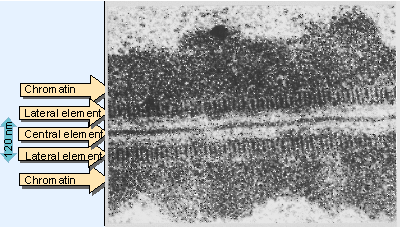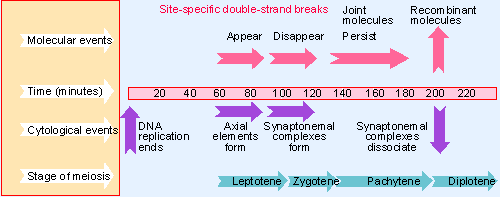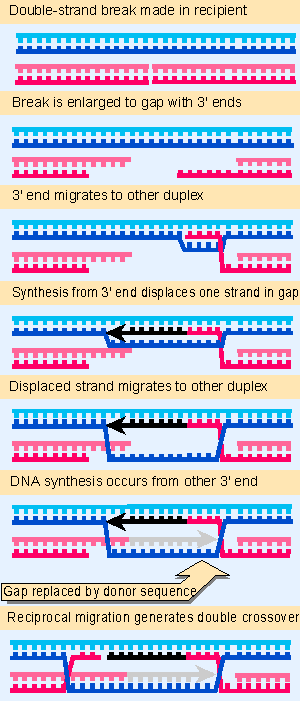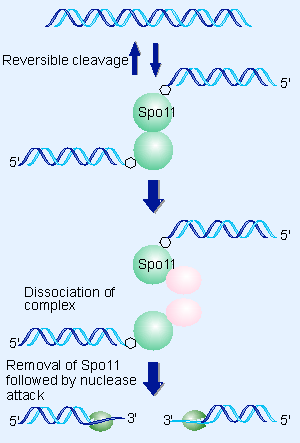4. Double-strand breaks initiate synapsis
14.4 Double-strand breaks initiate synapsis |
A basic paradox in recombination is that the parental chromosomes never seem to be in close enough contact for recombination of DNA to occur. The chromosomes enter meiosis in the form of replicated (sister chromatid) pairs, visible as a mass of chromatin. They pair to form the synaptonemal complex, and it has been assumed for many years that this represents some stage involved with recombination, possibly a necessary preliminary to exchange of DNA. A more recent view is that the synaptonemal complex is a consequence rather than a cause of recombination. However, we have yet to define how the structure of the synaptonemal complex relates to molecular contacts between DNA molecules (for review see Zickler and Kleckner, 1999).
 |
Figure 14.6 The synaptonemal complex brings chromosomes into juxtaposition. This example of Neotellia was kindly provided by M. Westergaard and D. Von Wettstein. |
Synapsis begins when each chromosome (sister chromatid pair) condenses around a structure called the axial element, which is apparently proteinaceous. Then the axial elements of corresponding chromosomes become aligned, and the synaptonemal complex forms as a tripartite structure, in which the axial elements, now called lateral elements, are separated from each other by a central element. Figure 14.6 shows an example.
Each chromosome at this stage appears as a mass of chromatin bounded by a lateral element. The two lateral elements are separated from each other by a fine but dense central element. The triplet of parallel dense strands lies in a single plane that curves and twists along its axis. The distance between the homologous chromosomes is considerable in molecular terms, more than 200 nm (the diameter of DNA is 2 nm). So a major problem in understanding the role of the complex is that, although it aligns homologous chromosomes, it is far from bringing homologous DNA molecules into contact.
The only visible link between the two sides of the synaptonemal complex is provided by spherical or cylindrical structures observed in fungi and insects. They lie across the complex and are called nodes or recombination nodules; they occur with the same frequency and distribution as the chiasmata. Their name reflects the hope that they may prove to be the sites of recombination.
 |
Figure 14.7 Double-strand breaks appear when axial elements form, and disappear during the extension of synaptonemal complexes. Joint molecules appear and persist until DNA recombinants are detected at the end of pachytene. |
The correlation between recombination and synaptonemal complex formation is well established, and recent work has shown that all mutations that abolish chromosome pairing in Drosophila or in yeast also prevent recombination. There are few systems in which it is possible to compare molecular and cytological events at recombination, but recently there has been progress in analyzing meiosis in S. cerevisiae. The relative timing of events is summarized in Figure 14.7.
There is good evidence in yeast that double strands initiate recombination in both homologous and site-specific recombination. Double-strand breaks were initially implicated in the change of mating type, which involves the replacement of one sequence by another (discussed in detail in 17 Rearrangement of DNA). Double-strand breaks also occur early in meiosis at sites that provide hotspots for recombination. Their locations are not sequence-specific. They tend to occur in promoter regions and in general to coincide with more accessible regions of chromatin. The frequency of recombination declines in a gradient on one or both sides of the hotspot. The hotspot identifies the site at which recombination is initiated; and the gradient reflects the probability that the recombination events will spread from it.
 |
Figure 14.5 Recombination is initiated by a double-strand break, followed by formation of single-stranded 3 F ends, one of which migrates to a homologous duplex. |
We may now interpret this idea in molecular terms. The flush ends created by the double-strand break are rapidly converted on both sides into long 3′ single-stranded ends, as shown in the model of Figure 14.5. A yeast mutation (rad50) that blocks the conversion of the flush end into the single-stranded protrusion is defective in recombination. This suggests that double-strand breaks are necessary for recombination. The gradient is determined by the declining probability that a single-stranded region will be generated as distance increases from the site of the double Vstrand break.
 |
Figure 14.8 Spo11 is covalently joined to the 5 F ends of double-strand breaks. |
In rad50 mutants, the 5′ ends of the double-strand breaks are connected to the protein Spo11, which is homologous to the catalytic subunits of one family of type II topoisomerases. This suggests that the topoisomerase may be the enzyme that generates the double-strand breaks. The model for this reaction shown in Figure 14.8 suggests that Spo11 interacts reversibly with DNA; the break is converted into a permanent structure by an interaction with another protein that dissociates the Spo11 complex. Then removal of Spo11 is followed by nuclease action. At least 9 other proteins are required to process the double-strand breaks. One group of proteins is required to convert the double-strand breaks into protruding 3′ VOH single-stranded ends. Another group then enables the single-stranded ends to invade homologous duplex DNA.
Double-strand breaks appear and then disappear over a 60 minute period. The first joint molecules, which are putative recombination intermediates, appear soon after the double Vstrand breaks disappear. The sequence of events suggests that double-strand breaks, individual pairing reactions, and formation of recombinant structures occur in succession at the same chromosomal site.
Double-strand breaks appear during the period when axial elements form. They disappear during the conversion of the paired chromosomes into synaptonemal complexes. This relative timing of events suggests that formation of the synaptonemal complex results from the initiation of recombination via the introduction of double Vstrand breaks and their conversion into later intermediates of recombination. This idea is supported by the observation that the rad50 mutant cannot convert axial elements into synaptonemal complexes. This refutes the traditional view of meiosis that the synaptonemal complex represents the need for chromosome pairing to precede the molecular events of recombination.
It has been difficult to determine whether recombination occurs at the stage of synapsis, because recombination is assessed by the appearance of recombinants after the completion of meiosis. However, by assessing the appearance of recombinants in yeast directly in terms of the production of DNA molecules containing diagnostic restriction sites, it has been possible to show that recombinants appear at the end of pachytene. This clearly places the completion of the recombination event after the formation of synaptonemal complexes.
So the synaptonemal complex forms after the double Vstrand breaks that initiate recombination, and it persists until the formation of recombinant molecules. It does not appear to be necessary for recombination as such, because some mutants that lack a normal synaptonemal complex can generate recombinants. Mutations that abolish recombination, however, also fail to develop a synaptonemal complex. This suggests that the synaptonemal complex forms as a consequence of recombination, following chromosome pairing, and is required for later stages of meiosis. A yeast mutation (zip1) in synaptonemal complex formation has the consequence of abolishing crossover interference (the ability of one recombination event to inhibit the occurrence of another nearby). This suggests the possibility that synaptonemal complex formation may be initiated at the site of a recombination event, and that the spread of the complex along the chromosome itself inhibits the occurrence of further recombination events. In this case, recombination events would not all be initiated simultaneously, and the synaptonemal complex could form during a period while recombination is initiated, and before the process is completed. The proposal that the synaptonemal complex inhibits recombination is an ironic contrast with the earliest ideas that it might be responsible for recombination!
Mutations in proteins that are needed for axial elements to form (these are the cohesins discussed in 27 Cell cycle and growth regulation) do not prevent the formation of double-strand breaks, but block formation of recombinants. The cohesins that are used in meiosis include Smc3p (which is also used in mitosis) and Rec8p (which is specific to meiosis and is related to the mitotic cohesin Scc1p) (Klein et al., 1999). The cohesins appear to bind to specific sites along the chromosomes in both mitosis and meiosis (Blat and Kleckner, 1999). They are likely to play a structural role in chromosome segregation. At meiosis, the formation of the axial elements may be necessary for recombination.
We can distinguish the processes of pairing and synaptonemal complex formation by the effects of two mutations, each of which blocks one of the processes without affecting the other.
The zip2 mutation allows chromosomes to pair, but they do not form synaptonemal complexes. So recognition between homologues is independent of recombination or synaptonemal complex formation.
The specificity of association between homologous chromosomes is controlled by the gene hop2 in S. cerevisiae. In hop2 mutants, normal amounts of synaptonemal complex form at meiosis, but the individual complexes contain nonhomologous chromosomes. This suggests that the formation of synaptonemal complexes as such is independent of homology (and therefore cannot be based on any extensive comparison of DNA sequences). The usual role of Hop2 is to prevent nonhomologous chromosomes from interacting.
Double-strand breaks form in the mispaired chromosomes in the synaptonemal complexes of hop2 mutants, but they are not repaired. This suggests that, if formation of the synaptonemal complex requires double-strand breaks, it does not require any extensive reaction of these breaks with homologous DNA.
It is not clear what usually happens during pachytene, before DNA recombinants are observed. It may be that this period is occupied by the subsequent steps of recombination, involving the extension of strand exchange, DNA synthesis, and resolution.
At the next stage of meiosis (diplotene), the chromosomes shed the synaptonemal complex; then the chiasmata become visible as points at which the chromosomes are connected. This has been presumed to indicate the occurrence of a genetic exchange, but the molecular nature of a chiasma is unknown. It is possible that it represents the residuum of a completed exchange, or that it represents a connection between homologous chromosomes where a genetic exchange has not yet been resolved. Later in meiosis, the chiasmata move toward the ends of the chromosomes. This flexibility suggests that they represent some remnant of the recombination event, rather than providing the actual intermediate.
Recombination events occur at discrete points on meiotic chromosomes, but we cannot as yet correlate their occurrence with the discrete structures that have been observed, that is, recombination nodules and chiasmata. However, insights into the molecular basis for the formation of discontinuous structures are provided by the identification of proteins involved in yeast recombination that can be localized to discrete sites. These include MSH4 (which is related to bacterial proteins involved in mismatch-repair; see below), and Dmc1 and Rad51 (which are homologs of the E. coli RecA protein). The exact roles of these proteins in recombination remain to be established.
Recombination events are subject to a general control. Only a minority of interactions actually mature as crossovers, but these are distributed in such a way that typically each pair of homologs acquires only 1 V2 crossovers, yet the probability of zero crossovers for a homolog pair is very low (<0.1%). This process is probably the result of a single crossover control, because the nonrandomness of crossovers is generally disrupted in certain mutants. Furthermore, the occurrence of recombination is necessary for progress through meiosis, and a "checkpoint" system (see 27 Cell cycle and growth regulation) exists to block meiosis if recombination has not occurred. (The block is lifted when recombination has been successfully completed; this system provides a safeguard to ensure that cells do not try to segregate their chromosomes until recombination has occurred.)
This section updated 1-21-2000
| Reviews | |
| Zickler, D. and Kleckner, N. (1999). Meiotic chromosomes: integrating structure and function.. Ann. Rev. Genet. 33, 603-754. | |
| Research | |
| Blat. Y and Kleckner, N. (1999). Cohesins bind to preferential sites along yeast chromosome III, with differential regulation along arms versus the centri region.. Cell 98, 249-259. | |
| Klein, F. et al. (1999). A central role for cohesins in sister chromatid conhesion, formation of axial elements, and recombination during yeast meiosis.. Cell 98, 91-103. | |